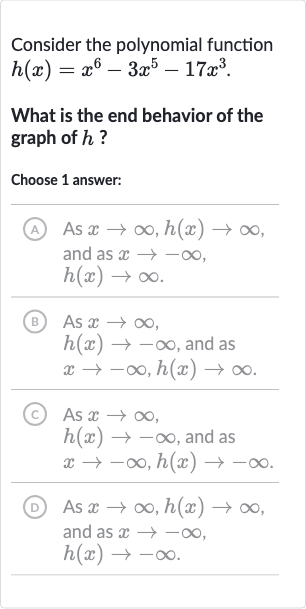Full solution
Q. Consider the polynomial function . What is the end behavior of the graph of ?Choose answer:(A) As , and as .(B) As , and as .(C) As , and as .(D) As , and as .
- Identify Leading Term: The problem asks us to determine the end behavior of the graph of the polynomial function . To do this, we need to consider the leading term of the polynomial, as it dictates the end behavior of the graph.
- Analyze Leading Coefficient: The leading term of is . The coefficient of this term is positive, and the degree is even. The end behavior of polynomial functions is determined by the leading term. For even-degree polynomials with a positive leading coefficient, as approaches infinity, the function approaches infinity, and as approaches negative infinity, the function also approaches infinity.
- Determine End Behavior: Therefore, based on the leading term , we can conclude that as approaches infinity (), approaches infinity (), and as approaches negative infinity (), also approaches infinity (). This matches option in the given choices.
More problems from Compare linear and exponential growth
QuestionGet tutor help
QuestionGet tutor help
QuestionGet tutor help
QuestionGet tutor help
QuestionGet tutor help
QuestionGet tutor help
QuestionGet tutor help

